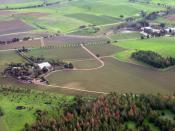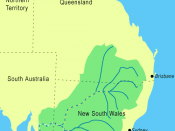The nation has a major concern, salinity, as it is slowly but surely consuming Australia, especially in the rural areas. The people have become increasingly aware of the problem of salinity, as the damage is widespread and visible to all. The agriculture industry is suffering as the overall crop production has been slashed; but not only is the rural community suffering, effects are increasingly obvious in urban areas also. Drastic, but more importantly, swift action is fundamental for Australia, both for the people's wellbeing and to continue with its growth and prosperity as a nation.
Salinity has occurred over time with both natural and man-made causes contributing to the land's demise. Excess levels of salt brought naturally throughout the land have resulted from the scattering of salt from the blustery ocean winds and low levels of salt in the rainfall. Man contributed to salinity in Australia when the majority of European settlers came to Australia in the early nineteenth century.
The farmers treated the land as European land, so they cleared for pastures by uprooting vital trees, shrubs and other necessary vegetation. Consequently, when the pastures were watered, the plants did not absorb the water - instead it went straight under the surface and lay there, creating an underwater table. When the rain falls again, the water again drains straight under the surface and covers the first layer of water causing the water table to rise. When the water table reaches the earth's surface, the pasture is flooded. When the water evaporates, only a layer of salt remains. This process is known as dryland salinity. Irrigation salinity is the other type of salinity, which occurred when farmers abused the Murray - Darling water by pumping back into the river the salty dregs of the water used to farm their land.


